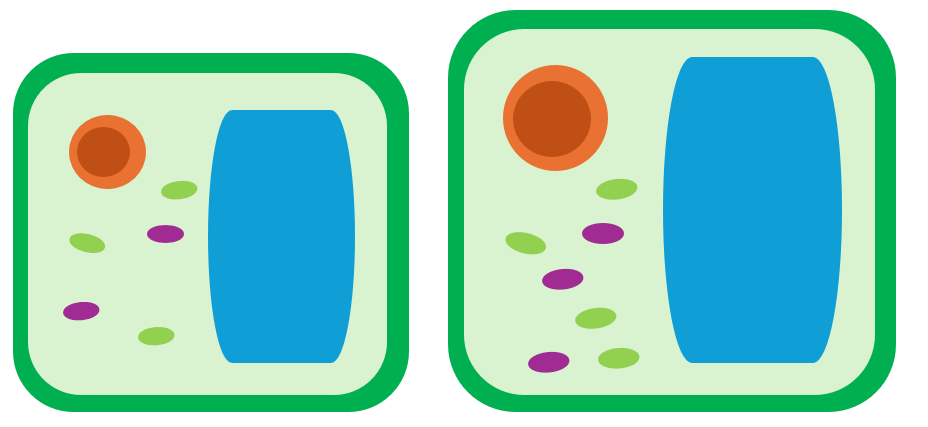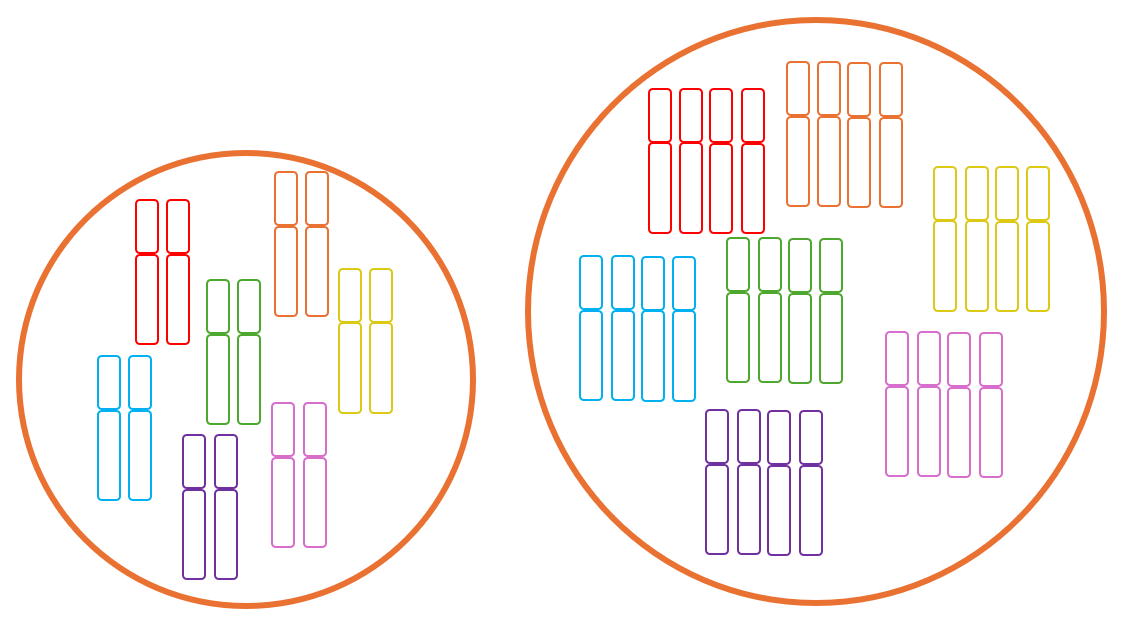By Linn Huser


Diploids and Tetraploids in Grassland Leys - Diversity in Varieties for Rich and Robust Fields
By Linn Huser
In a grass mixture you might find several varieties of the same species. One of the varieties will often have “tet.” in their name on the Cotswold Seeds website. Here, “tet.” is short for tetraploid, which refers to the genetic makeup of the variety. Other varieties in mixtures can be diploid, and this article will shine a light on the differences between tetraploid and diploid varieties and the effect this has on a grassland ley.
The Bigger the Better!
In simple terms, tetraploid plants have twice the amount of genetic material compared to diploids. In fact, the prefixes of the names di- and tetra- are derived from Greek and mean two and four respectively – diploid plants have two sets of every gene, and tetraploids have four sets of every gene. The effect of this in grasses is often obvious just by looking at the size of the seeds and the plants: tetraploid varieties have bigger cells due to the increase in genetic material, which in turn makes the plants and the seeds bigger. The bigger cells in tetraploids hold more water than diploid cells, which allows for more water-soluble carbohydrates1. Further, because the thickness of the cell walls does not increase proportionally with the cell size, tetraploids are generally more palatable than diploids for grazing1. In fact, in a mixed sward, a grazing herd will prefer the tetraploid plants and graze them lower2,3. When sown, tetraploids tend to establish faster than diploids which can be explained by the seed size: a bigger seed stores more energy to kick off germination and early growth.

Simplified illustrations of diploid and tetraploid plant cells, with the cell nucleus in orange, water vacuole in blue and chlorophylls and mitochondria in green and purple respectively. The dark green cell wall encloses the cells. CCBY Linn Huser
For All the Advantages there are Disadvantages
For all these pros of choosing a tetraploid grass over a diploid, there are correlating cons. More water in a cell means that the nutrition is more diluted, and therefore tetraploids are not as dense in nutrition as diploids3, and the dry matter yield is lower in haymaking and silage4. Further, more water makes tetraploids more susceptible to freezing in cold temperatures and drying out in dry conditions due to the higher water uptake requirement5,6. A tetraploid plant, being bigger and more energetic, also runs out of life faster, and the persistence is therefore commonly shorter than for diploid plants7.
At the Mercy of the Caucasian Honeybee
In grasslands there are several species that have different levels of ploidy. The most common are the ryegrasses, festucas, timothy, and red clover. In red clover, where the tetraploids again are bigger and bolder, we also find bigger flower heads which are compensated with fewer flowers per plant8. The floral tubes in the tetraploids are, you guessed it, bigger and longer, which creates a problem. There is only one honeybee that can pollinate red clover flowers – the Caucasian honeybee8. This is the only honeybee with a tongue long enough to reach into the tetraploid flower tubes and sap the nectar and spread the pollen, and with lower success rate of pollination there will be a lower seed yield. In fact, seed yield in diploids can be twice as high as in tetraploids8.
Let us take a step back. We now appreciate the effect of the different levels of ploidy, but – what is ploidy?

Two of the red clover varieties above are tetraploid, and two are diploid. Can you tell them apart based on size? What about the length of the roots? What does this tell us about plant breeding and modern varieties? CCBY Linn Huser
The Pollen Grain Down the Stigma Lane
Humans have two sets of every gene, one we received from our mother and the other set from our father. The same is true for plants, a pollen grain with one gene set fertilises an egg cell with another gene set in the mother plant and creates a seed. This seed with a double set of all genes is called diploid, which is Greek for double. The pollen and egg cells individually are haploid, which is Greek for single, as they only have one set of each gene. In contrast to humans who are all diploid, plants can have more than two sets of genetic material, making them triploid (three gene sets), tetraploid (four gene sets) or hexaploid (six gene sets).
The Genetics and the Greek
The gene sets in all cells are the long strings of DNA which constitute all of the genes in an organism. In genetics, the individual gene set is called chromosome, which is referred to as n. Humans, being all diploid, are therefore 2n, as we have two sets of each chromosome. In total we have 46 chromosomes, which is written like 2n = 46. Solving for n, we get n = 46/2 = 23: we have 23 chromosome pairs (23 chromosomes from our mother and 23 chromosomes from our father). For a diploid plant, we follow the same expression. Take for example perennial ryegrass, which has in total 14 chromosomes in a diploid variety. Again, this is written as 2n = 14, and n = 7, meaning seven chromosome pairs. We already established that a tetraploid variety of perennial ryegrass has twice the amount of genetic material, alas 28 chromosomes. This is written out as: 2n = 4x = 28, here solving for x gives seven chromosome sets, meaning all the genes in one chromosome are present in four copies – one in each chromosome of a chromosome set. The same is true for other common species in mixed swards, the ryegrasses, festucas, timothy and red clover have varieties that are either diploid or tetraploid.

Simplified illustration of the cell nucleus in a diploid and in a tetraploid plant cell with n = 7 chromosome sets. CCBY Linn Huser
Plant Breeding – Au Naturale or Sci-Fi?
Tetraploid grasses and red clovers in agriculture are all human made through breeding. The process of inducing tetraploidy from diploid parents includes cell cycle disruption with chemicals, allowing for chromosome doubling. However, this does also happen in nature, and white clover only exists as a tetraploid variety (no one has yet been able to identify the ancestor parents, expected to be diploid)9. Today however, all the cultivated varieties of these plants are a result of breeding, selecting for the individuals that perform better in a particular environment and breeding these. Due to the continuous breeding on both diploid and tetraploid varieties, the differences between modern diploids and tetraploids in performance is today minimal and decreasing, improving all varieties independent on ploidy level towards higher yield and higher nutritional content in future unstable climates.
Fun Facts
- The game Tetris is an example of Greek in our everyday life. If you haven’t already realised, all the figures are made from four building blocks!
- Wheat exists as not only diploid and tetraploid, but also hexaploid! The diploid wheat is called Einkorn, and not much used today. Tetraploid wheat is durum wheat, used for pasta and commonly grown in the Mediterranean region. Hexaploid wheat is the common bread wheat used for baking, with a high gluten content making bread doughs elastic.
- The wild potato can be octoploid – eight copies of each chromosome! What is more, diploid ferns can have up to 1,260 chromosomes!
- Plant breeding has created a few triploid plants. As three sets of genes cannot be evenly split for sexual reproduction to pollen grains and egg cells, these plants are sterile. What is that good for? Well – sterile fruits do not produce seeds, and examples of modern triploid fruits are watermelon, grapes and bananas!
- There are rare conditions in humans of chromosome abnormality, these include Downs syndrome (three copies of chromosome 21) and Turner syndrome (only one copy of chromosome 23).
References
1. Solomon, Juan Kevin Quamina. 2013. ‘Cattle Grazing Preferences, Animal Performance, and Harvest Management Effects among Diploid and Tetraploid Cultivars of Annual Ryegrass’. Ph.D., United States -- Mississippi: Mississippi State University. https://www.proquest.com/docview/1431169944/abstract/C603606FDB904485PQ/1.
2. Balocchi, Oscar A, and Ignacio F López. 2009. ‘Herbage Production, Nutritive Value and Grazing Preference of Diploid and Tetraploid Perennial Ryegrass Cultivars (Lolium Perenne L.)’. Chilean Journal of Agricultural Research 69 (3). https://doi.org/10.4067/S0718-58392009000300005.
3. McKenna, Patrick, Nicola Cannon, John Conway, and John Dooley. 2018. ‘The Use of Red Clover (Trifolium Pratense) in Soil Fertility-Building: A Review’. Field Crops Research 221 (May):38–49. https://doi.org/10.1016/j.fcr.2018.02.006.
4. Reheul, Dirk, J. Baert, and A. Ghesquiere. 2003. ‘Progress in breeding perennial fodder grasses. 1. In search of tetraploid ryegrass with a higher dry matter (DM) content’. Czech Journal of Genetics and Plant Breeding 39:54–56.
5. Sugiyama, Shuichi. 1998. ‘Differentiation in Competitive Ability and Cold Tolerance between Diploid and Tetraploid Cultivars in Lolium Perenne’. Euphytica 103 (1): 55–59. https://doi.org/10.1023/A:1018322821118.
6. Sugiyama, Shu-ichi. 2006. ‘Responses of Shoot Growth and Survival to Water Stress Gradient in Diploid and Tetraploid Populations of Lolium Multiflorum and L. Perenne’. Grassland Science 52 (4): 155–60. https://doi.org/10.1111/j.1744-697X.2006.00062.x.
7. Roegiers, P., D. Reheul, and G. van Bogaert. 1988. ‘The Persistence of Tetraploid Perennial Ryegrass in a Mixture with Diploid Perennial Ryegrass’. Journal of Agronomy and Crop Science 161 (1): 40–44. https://doi.org/10.1111/j.1439-037X.1988.tb00641.x.
8. Liatukas, Žilvinas, and Jovita Bukauskaitė. 2012. ‘Differences in Yield of Diploid and Tetraploid Red Clover in Lithuania’. Proceedings of the Latvian Academy of Sciences. Section B. Natural, Exact, and Applied Sciences 66 (4–5): 163–67. https://doi.org/10.2478/v10046-012-0023-y.
9. Ellison, Nick W., Aaron Liston, Jeffrey J. Steiner, Warren M. Williams, and Norman L. Taylor. 2006. ‘Molecular Phylogenetics of the Clover Genus (Trifolium—Leguminosae)’. Molecular Phylogenetics and Evolution 39 (3): 688–705. https://doi.org/10.1016/j.ympev.2006.01.004.
Author: Linn Huser
Date Posted: 5th August 2024



